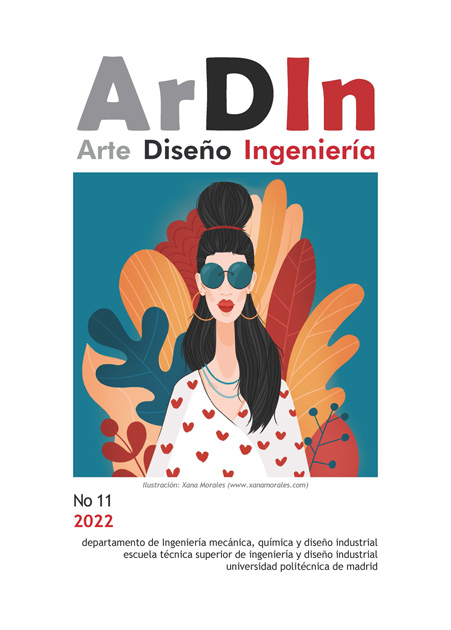Linking the industrial design from the Bauhaus to current perspectives = Vinculando el diseño industrial de la Bauhaus a las perspectivas actuales
DOI:
https://doi.org/10.20868/ardin.2022.11.4807Resumen
Resumen
La Bauhaus es considerada una de las escuelas más influyentes en lo que respecta al diseño industrial. Sin embargo, el escenario actual es realmente diferente al presente durante la Bauhaus, y la práctica del diseño industrial ha evolucionado durante el último siglo. Este artículo, compara ambos enfoques en función de algunas características clave del diseño, como el contexto, los participantes involucrados y la innovación, para encontrar similitudes y diferencias. Esta comparación, basada en principios actuales, proporcionará una descripción general del diseño industrial de la Bauhaus y su relación y posible influencia sobre la práctica actual.
Abstract
The Bauhaus is considered one of the most influential schools of modern time when it comes to industrial design. However, the current scenario is different from the one the Bauhaus found itself, and industrial design practice has evolved during the last century. This article will compare both approaches based on key features of design, such as context, involved stakeholders and innovation, to find similarities and differences. This comparison based on current understandings will give an overview of the industrial design from the Bauhaus and its relatedness and possible influence on current practice.
Descargas
Referencias
Argan, G. C. (1957). Walter Gropius y la Bauhaus. Nueva Vision S.R.l.
Aldersey-Williams, H. (2000). Bauhaus: design or dogma? New Statesman, 129(4473), 41-43.
Bayer, H., Gropius, W., & Gropius, I. (1975). Bauhaus 1919–1928 (1st paperbound ed.). Museum of Modern Art.
Bazzara, L. E. (2015). El Diseño durante la Bauhaus y después de ella. Dos valoraciones estéticas. Question/Cuestión, 1(46), 11-19.
Benton, Scharf, C., Benton, Charlotte, Scharf, Aaron, & Open University. (1975). Design 1920's: German design and the Bauhaus 1925-32, modernism in the decorative arts, Paris 1910-30. Open University Press.
Dourish, P. (2004). What we talk about when we talk about context. Personal and ubiquitous computing, 8(1), 19-30.
Eadicicco, L. (2017, June 29). This Is Why the iPhone Upended the Tech Industry. Time. Retrieved March 8, 2022, from https://time.com/4837176/iphone-10th-anniversary/
Frommer, D. (2011, June 17). HISTORY LESSON: How The iPhone Changed Smartphones Forever. Business Insider. Retrieved March 8, 2022, from https://www.businessinsider.com/iphone-android-smartphones-2011-6?international=true&r=US&IR=T#apples-gesture-interface-quickly-became-the-blueprint-for-all-phones-2
Giaccardi, E., & Redström, J. (2020). Technology and more-than-human design. Design Issues, 36(4), 33-44.
Gordon, A., Rohrbeck, R., & Schwarz, J. O. (2019). Escaping the" faster horses" trap: bridging strategic foresight and design-based innovation. Technology innovation management review, 9(8), 30-42.
Grady, C. (2019, December 23). The 2010s were supposed to bring the ebook revolution. It never quite came. Vox. Retrieved March 11, 2022, from https://www.vox.com/culture/2019/12/23/20991659/ebook-amazon-kindle-ereader-department-of-justice-publishing-lawsuit-apple-ipad
Hochman, E. S. (2002). La Bauhaus, Crisol De La Modernidad. Paidós Ibérica Ediciones S A.
Le Masson, P., Hatchuel, A., & Weil, B. (2016). Design theory at Bauhaus: teaching “splitting” knowledge. Research in Engineering Design, 27(2), 91-115.
Meissner, E. (1987). El movimiento Bauhaus y su proyección en la cultura del siglo XX. Arquitecturas del Sur, 3(11), 2-6.
Mahoney, P. G. (2008, August 7). Industrial Design: Design the Dyson Way. Machine Design. Retrieved March 14, 2022, from https://www.machinedesign.com/news/article/21817656/industrial-design-design-the-dyson-way
Molla, R. (2017, June 26). How Apple’s iPhone changed the world: 10 years in 10 charts. Vox. Retrieved March 8, 2022, from https://www.vox.com/2017/6/26/15821652/iphone-apple-10-year-anniversary-launch-mobile-stats-smart-phone-steve-jobs
Naylor, G. (1985). The Bauhaus Reasessed: sources and design theory. Herbert Press.
Pierce, D. (2017, December 20). The Kindle Changed the Book Business. Can It Change Books? Wired. Retrieved March 11, 2022, from https://www.wired.com/story/can-amazon-change-books/
Poon, S. (2019). From Tubular Steel to Flat Pack: A Case Study Comparison Between Bauhaus and IKEA Innovation Leadership in Contemporary Design. Human Factors and Ergonomics Journal, 4(1), 25–31.
Sanders, E. B. N., & Stappers, P. J. (2012). Convivial toolbox: Generative research for the front end of design. Bis.
Shelley, C. (2015). The nature of simplicity in Apple design. The Design Journal Vol. 18, Issue 3, pp. 439–456. Informa UK Limited. https://doi.org/10.1080/14606925.2015.1059609
Sleeswijk Visser, F., & Stappers, P. J. (2011). A gentle introduction to context. Reader Context & Conceptualisation, 7–17.
Sleeswijk Visser, F., Stappers, P. J., Van der Lugt, R., & Sanders, E. B. (2005). Contextmapping: experiences from practice. CoDesign, 1(2), 119-149.
Smits, A. A. J., & Bodewes, W. (2011). SENZ Umbrellas: taking the world by storm. European Case Clearing House.
Statista (2021). eBooks - Worldwide. Retrieved March 11, 2022, from https://www-statista-com.tudelft.idm.oclc.org/outlook/dmo/digital-media/epublishing/ebooks/worldwide
Tyler, J. (2018, October 12). Here are IKEA’s secrets to keeping its prices so low. Business Insider Nederland. https://www.businessinsider.nl/why-ikea-is-so-cheap-2018-10?international=true&r=US
Voûte, E., Stappers, P. J., Giaccardi, E., Mooij, S., & van Boeijen, A. (2020). Innovating a large design education program at a university of technology. She Ji: The Journal of Design, Economics, and Innovation, 6(1), 50-66.
Yu, R. (2019). Core Elements of IKEA’s Successful Product Design. Journal of Physics: Conference Series, 1168, 032118. doi:10.1088/1742-6596/1168/3/032118
Descargas
Publicado
Número
Sección
Licencia
- Los autores conservan los derechos de autor y garantizan a la revista el derecho de una Licencia Creative Commons Atribución - Nocomercial 4.0 Internacional (CC BY NC ND) que permite a otros compartir el trabajo con un reconocimiento de la autoría y uso no comercial.
- Los autores pueden establecer por separado acuerdos adicionales para la distribución no exclusiva de la versión de la obra publicada en la revista (por ejemplo, situarlo en un repositorio institucional o publicarlo en un libro).
- Salvo indicación contraria, todos los contenidos de la edición electrónica se distribuyen bajo una licencia de uso y distribución “Creative Commons"













